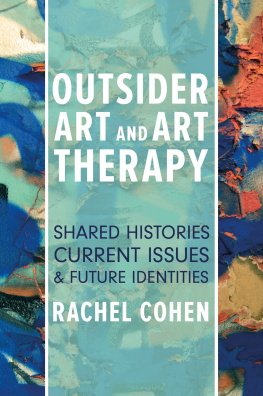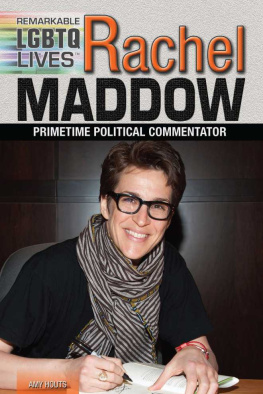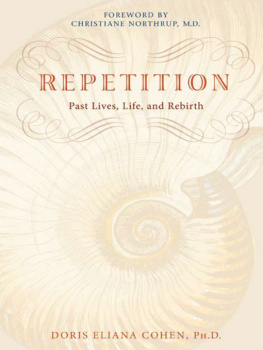Rachel Cohen - Outsider Art and Art Therapy: Shared Histories, Current Issues, and Future Identities
Here you can read online Rachel Cohen - Outsider Art and Art Therapy: Shared Histories, Current Issues, and Future Identities full text of the book (entire story) in english for free. Download pdf and epub, get meaning, cover and reviews about this ebook. year: 2017, publisher: Jessica Kingsley Publishers, genre: Art. Description of the work, (preface) as well as reviews are available. Best literature library LitArk.com created for fans of good reading and offers a wide selection of genres:
Romance novel
Science fiction
Adventure
Detective
Science
History
Home and family
Prose
Art
Politics
Computer
Non-fiction
Religion
Business
Children
Humor
Choose a favorite category and find really read worthwhile books. Enjoy immersion in the world of imagination, feel the emotions of the characters or learn something new for yourself, make an fascinating discovery.
- Book:Outsider Art and Art Therapy: Shared Histories, Current Issues, and Future Identities
- Author:
- Publisher:Jessica Kingsley Publishers
- Genre:
- Year:2017
- Rating:3 / 5
- Favourites:Add to favourites
- Your mark:
- 60
- 1
- 2
- 3
- 4
- 5
Outsider Art and Art Therapy: Shared Histories, Current Issues, and Future Identities: summary, description and annotation
We offer to read an annotation, description, summary or preface (depends on what the author of the book "Outsider Art and Art Therapy: Shared Histories, Current Issues, and Future Identities" wrote himself). If you haven't found the necessary information about the book — write in the comments, we will try to find it.
Rachel Cohen: author's other books
Who wrote Outsider Art and Art Therapy: Shared Histories, Current Issues, and Future Identities? Find out the surname, the name of the author of the book and a list of all author's works by series.
Outsider Art and Art Therapy: Shared Histories, Current Issues, and Future Identities — read online for free the complete book (whole text) full work
Below is the text of the book, divided by pages. System saving the place of the last page read, allows you to conveniently read the book "Outsider Art and Art Therapy: Shared Histories, Current Issues, and Future Identities" online for free, without having to search again every time where you left off. Put a bookmark, and you can go to the page where you finished reading at any time.
Font size:
Interval:
Bookmark:

OUTSIDER
ART AND ART
THERAPY
SHARED HISTORIES,
CURRENT ISSUES,
AND FUTURE IDENTITIES
RACHEL COHEN

Jessica Kingsley Publishers
London and Philadelphia
CONTENTS
LIST OF IMAGES
Introduction
Shared Histories in Mental Health
Shared Histories in Art
.
.
.
.
.
Art Therapy
Outsider Art
Continuums of Meaning
COLOR PLATES
PREFACE
I began this line of research into art therapy and contemporary art during my graduate studies, seeking out some way to connect what I did in my studio to the work style that I was developing. Outsider art seemed to be the logical first step in resituating art created in a therapeutic context into a contemporary dialogue, and, hence, I became intimately familiar with all of the problems of definition and terminology that plague outsider art and the parallel concerns that also apply to the contemporary idea of art therapy.
The focus of this book boils down to artmaking and art appreciating and what these ideas mean in a historic and contemporary context. Ultimately, it is ideas of cultural normalcy that end up influencing ideas of art, and ideas of what sick and healthy mean and what effect these labels can have on the individuals they are applied to.
Ill speak plenty on my decision to use the term outsider but it is worth admitting that even though I find it good enough and necessary to use in this context, it doesnt mean that outsiders dont deserve recognition and a place on the inside. By starting to reconcile some of the issues stratifying art therapy from contemporary art lines of inquiry begun by Susan Hogan (2001), Cathy Moon (2002), and Linney Wix (2000, 2009, 2010) my hope is that the gap closes, and more people are able to connect with art, both making and viewing, in a meaningful way.
The majority of the artwork featured in this book comes from active, living artists working in studio programs an important topic in reconciling contemporary art and art therapy. A special thank you to LAND Gallery in Brooklyn, NY; Housing Works in Brooklyn, NY; NIAD Art Center in Richmond, CA; Pyramid Inc. in Tampa, FL; Creative Growth Art Center in Oakland, CA; and to all of the featured artists, for sharing their incredible work with the world.
INTRODUCTION
A section of this book was written while I was traveling alone in Budapest a foreign place with a foreign culture and language.
The experience became a metaphor I used to frame what happens when we view art; we are invited in to explore an artists work, produced in his or her unique visual language. As with traveling to extend the metaphor the more familiar the artistic language is, the less intimidating it is to view the piece and to give an opinion on what we think of it. The Mona Lisa is a clear representation of a woman, in a representational style now widely understood, and hence, nearly everyone around the world feels comfortable declaring it to be good art.
But what about the completely foreign? We are faced with two choices ignore and avoid it, or jump right in and figure out a way to understand and be understood. If art on a basic level is the expression of self in the form of idiosyncratic visual language, then it goes without saying that the more foreign the language is, the harder it will be for a viewer to understand or engage with it. For this reason, scholars, academics, critics, dealers, and all immediate and peripheral figures that comprise the art world become elevated figures, as they are able to translate what pieces mean and how the wider public should feel about them. This, in turn, makes viewers more comfortable seeing, speaking, and understanding the language; in one hundred years, Cubism went from a bastardization of traditional form to a universally-recognized, and appreciated, art historical movement.
However, when it comes to outsider art, we are often faced with a language that is, as the term implies, outside of what the everyday person knows to be art. The more that language resembles ours say, with Grandma Moses the quicker it becomes acceptable for those forms to quickly enter our mainstream consciousness. The more foreign and dense the imagery gets, the less comfortable we feel looking at and consuming it. Hence, we look to translators art world insiders to help us become a little more comfortable seeing what, in a sense, is foreign and uncomfortable. With outsider art becoming a growing field within the realm of art world professionals, there are now specialized museum curators, auction specialists, and others to help us understand the language of these products.
But what about art therapists?
As I was thinking about the similarities between viewing art and traveling, it also helped place the role of the art therapist within this world of translating and reflecting an artists independent language to invite others into the viewing experience. Whether using art in a psychotherapy session or art in an open-studio setting, the art therapists role is to help a client identify and understand his or her own language. In psychotherapy, this may lead to interpretation and deepening on the part of the therapist, while in the studio, it may be to help an artist strengthen his or her own unique style.
This is an exceedingly important element of art therapy that gets glossed over in most of the literature and education, and is, in many ways, what makes the field unique from other peripherally related disciplines: we help people see .
Despite the fact that the field of art therapy essentially depends on visual language, oftentimes the art part is forgotten. There is little-to-no crossover between art therapy and the contemporary art world, and yet outsider art put simply, art created outside of the context of a traditional art world has surged in popularity. However, art therapy education focuses on the psychological, the diagnostic, and at times entirely omits the idea that there is a long history of art and a contemporary art world that is increasingly listening to voices that once went unheard and accepting of the idea that art can be a manifestation of the self, no matter the artists background.
Problems of Definition
The majority of the literature on outsider art makes reference to the issue of defining the field it is inherently defined by what it is not , art made by art world insiders. And yet, what makes one an insider? Hence, the umbrella usage of outsider has come to refer to everyone from individuals with mental illness, to Southern folk artists, to individual creators working according to their own context, unrecognized by the art mainstream. Therefore, outsider art is not a traditional art historical ism or school of art, or even definable by style (Cardinal 1994), but instead, a field that predicates acceptance of the artist and his or her biography in order to achieve outsider status, and on the product itself, which must be worthy of the designation of art.
This parallels with issues of defining art therapy. Primarily, both outsider art and art therapy can be considered overlapping due to the populations each encompasses clients who access art therapy range from individuals in day habilitation programs, to those visiting a private practice, to children in schools. As with outsider art, defining both art and therapy in terms of a contemporary art therapy practice are equally difficult. The use of the term art implies subjectivity, aesthetics, and cultural influence, for example; therefore, when we seek to reconcile the art part of art therapy, it is not necessarily just in the making it is in the recognizing of products as art. Plus, given the broad populations that access art therapy, it cannot be said that every art therapy process and practice has treatment in mind, hence even the term therapy is used in a broader context as well.
Next pageFont size:
Interval:
Bookmark:
Similar books «Outsider Art and Art Therapy: Shared Histories, Current Issues, and Future Identities»
Look at similar books to Outsider Art and Art Therapy: Shared Histories, Current Issues, and Future Identities. We have selected literature similar in name and meaning in the hope of providing readers with more options to find new, interesting, not yet read works.
Discussion, reviews of the book Outsider Art and Art Therapy: Shared Histories, Current Issues, and Future Identities and just readers' own opinions. Leave your comments, write what you think about the work, its meaning or the main characters. Specify what exactly you liked and what you didn't like, and why you think so.












